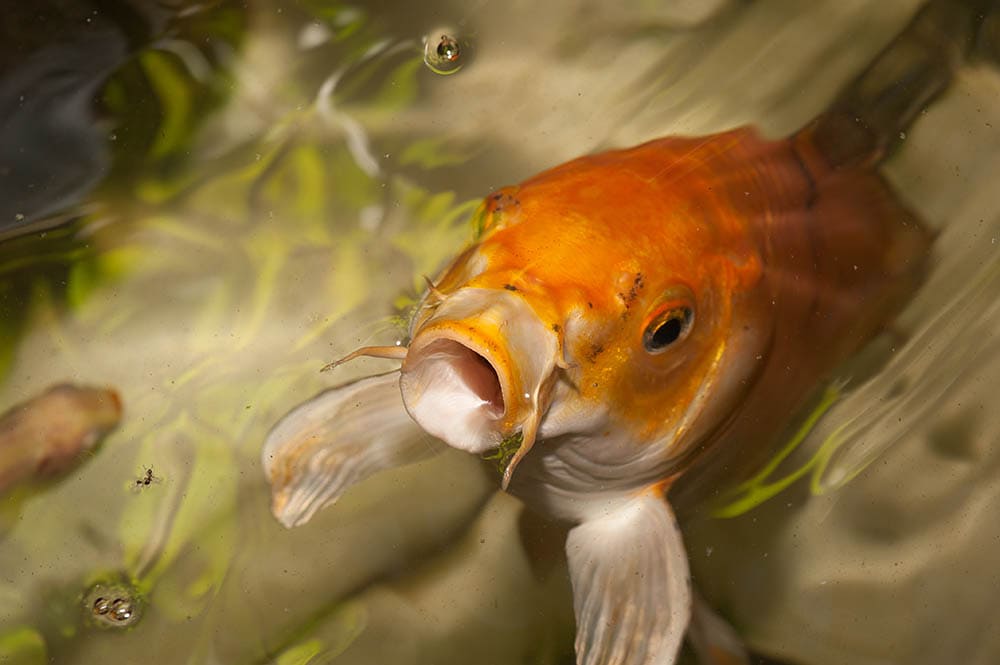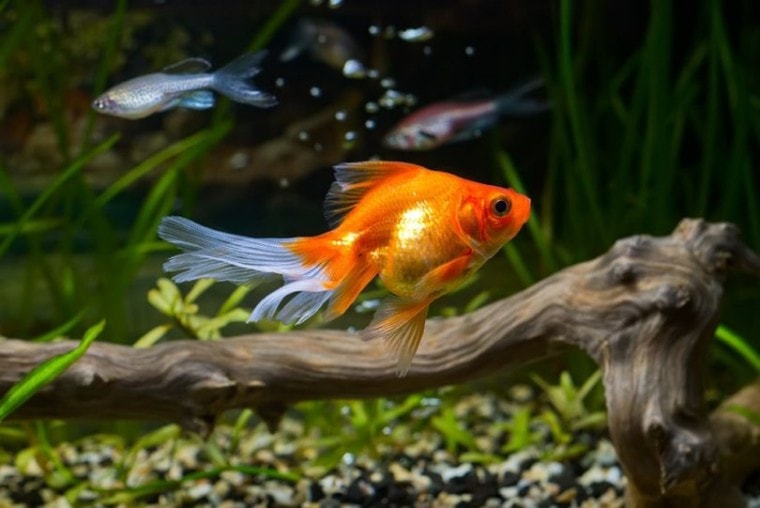
Goldfish are by far one of the most interesting pets in the hobby. Like all pets, they thrive when cared for properly. This means meeting all their needs and requirements so that you can experience many years with your beloved goldfish. We all want our pets to be healthy and happy, and this guide has some essential tips to keep a healthy and long-lived goldfish.
Goldfish get the reputation for being easy to care for, or that they make great pets for children. However, this is only true if they’re in an appropriate set up. If you want to ensure that you are doing the absolute best for your goldfish, you want to make sure you follow some particularly important steps in their care.
Surviving vs Thriving
As easy as it is to place a goldfish in a bowl and call it complete, this is not going to result in your goldfish thriving or being content with their environment. Although your goldfish may survive in the bowl, there is more to their care for many owners to understand. It is important to keep in mind that surviving is not thriving, and goldfish can relate to that phrase!
Goldfish make great additions to aquariums and bring a lot of joy in ownership to both adults and supervised children alike. We hope to help you understand goldfish care better while allowing you to have the opportunity to reap the benefits of providing a good home for your goldie and seeing them with bright colors and erect fins swimming happily around the tank.
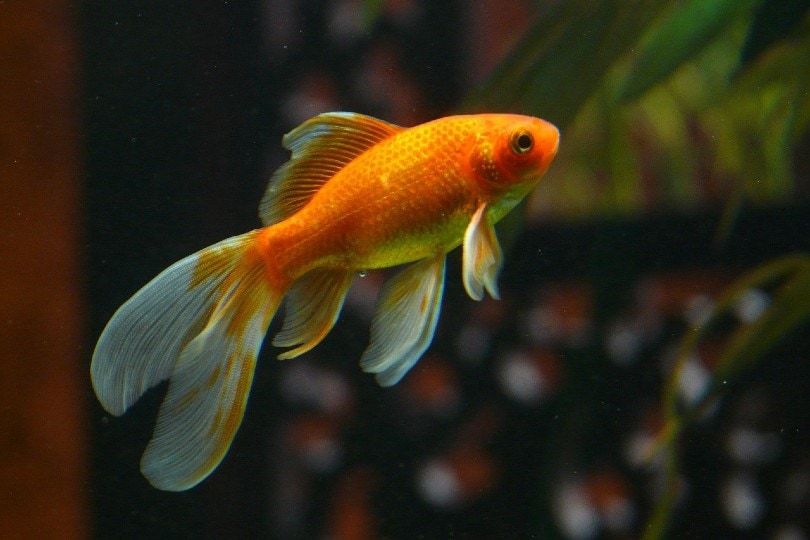
Essential Goldfish Items
Before you get your goldfish, you should ensure that you have all their necessary items beforehand. This will help you to care for them properly and make maintenance a lot easier.
Signs That Your Goldfish Is Thriving
It is not difficult to determine if your goldfish is thriving as there are a variety of factors that form part of the decision. Looking at the external body of your fish may give you a good indication.
The 10 Tips to Care for Your Goldfish
1. Tank Size
Contrary to popular belief, goldfish are not supposed to be housed in bowls or vases. These are simply too small to provide your goldfish with enough swimming space and still have room for all the essential equipment. Goldfish should be housed in a standard rectangular tank.
Consider the following guidelines as a good starting point:
Though housing goldfish alone isn’t advised, we’ve provided recommendations in the unfortunate event that you need to isolate an individual for a closer inspection, medication, or treatment for an ailment or disease.
We recommend larger tanks to beginners so there is more room for error. It is important to consider the adult size these fish grow to. Common goldfish can grow up to 12 inches. When choosing the best tank for your goldfish, ensure it has plenty of room for them to swim and grow. The tank should be able to fit a filter, aeration system, decoration, and any other tank necessities. It is easy to keep a goldfish healthy and happy in appropriate conditions, and a suitable size and shaped tank is a great way to start!
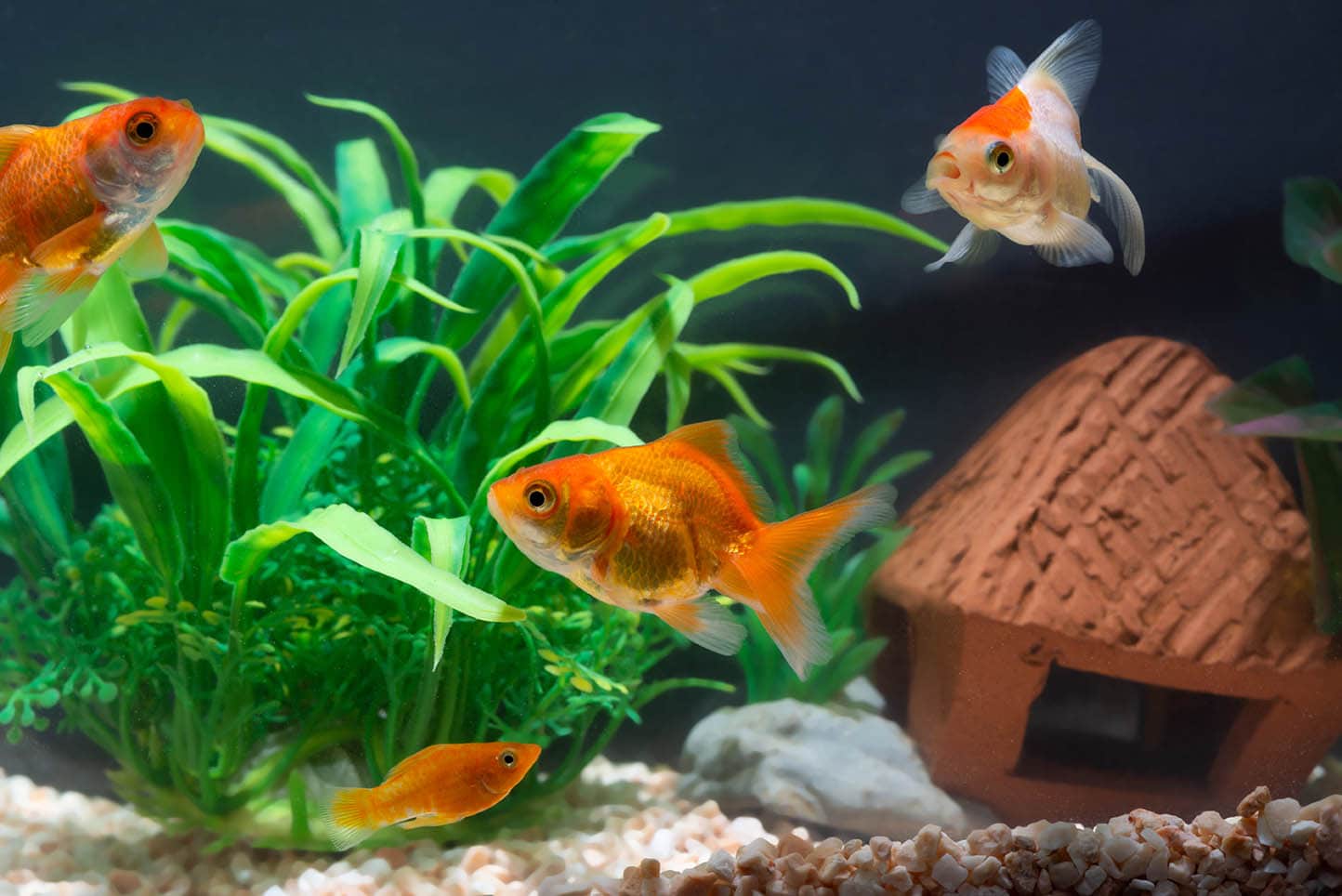
2. Water Parameters
Water is one of the most important steps to keep your goldfish healthy. Your goldfish depends on the water for basic survival mechanisms. The tank should regularly be replenished with clean and fresh water. Goldfish cannot survive in dirty water full of chemicals, pollutants, or spiking parameters (ammonia, nitrite, nitrate).
Ammonia and nitrite spikes are common in a tank that is uncycled or has not been properly maintained. Nitrate spikes are popular in tanks that have a high bioload and are not regularly cleaned. Water renewals are important to maintain water quality.
Disease and infections propagate in poorly maintained aquariums and this can be hazardous for your goldfish. Keep in mind that humans cannot visibly see the quality of the water with the naked eye. Water testing kits can tell us how safe or unsafe the water parameters are.
3. Filtration
All tanks require a filter to help keep the water clean. Aquarium filtration is the best way to mimic the natural filtration process which occurs in rivers, lakes, and streams in nature. There are three main methods of filtration: biological, chemical, or mechanical. Most filters utilize a combination of at least two of these methods. Goldfish can benefit from all three methods of filtration, and it will help them to thrive in their environment.
The filtration in your aquarium should be able to cycle through at least 5 times the tank’s volume per hour. For example, if you have a 50-gallon tank, the filter should be rated at around 250 gallons. Filters also help aerate the water by agitating the water surface.

4. Water Conditioner
Water found in taps all over the world is processed to render it safe for humans. This process involves the addition of chlorine, chloramine, and other chemicals into the water. Water may also contain heavy metals and trace amounts of ammonia (depending on the source). Therefore, water should always be conditioned with a water conditioner before being added to your goldfish tank. Water conditioners are readily available in pet stores and are relatively inexpensive. The bottles will usually have a measuring system on the label to inform you on how much dechlorinate to add per liter or gallon of water. This should be added to your aquarium before adding the fish and topped up with every water change.
If you are looking for help to get the water quality just right for your goldfish family in their aquarium, or just want to learn more about goldfish water quality (and more!), we recommend you check out the best-selling book, The Truth About Goldfish, on Amazon today. It covers everything from water conditioners to tank maintenance, and it also gives you full, hard copy access to their essential fishkeeping medicine cabinet!
5. Aeration Systems
Like all pet fish, goldfish require oxygen to breathe. They extract oxygen from the water, and being cold water fish, they have a high oxygen demand when compared to tropical fish of the same size as them. Cold water naturally holds more oxygen than warm water.
A well-functioning filter should aerate your water by gently agitating the water surface. This is because agitating the water’s surface allows carbon dioxide to escape and allows oxygen to enter. It also increases the surface area of the water.
These systems should be running constantly for 24 hours a day. Most of them will be energy-saving and cost little to routinely oxygenate the water.
Aquatic plants are also a great way of aerating water, because they produce oxygen via the process of photosynthesis. In addition, they also readily consume nitrates as fertilizer, forming a symbiotic relationship with fish that are housed with them.
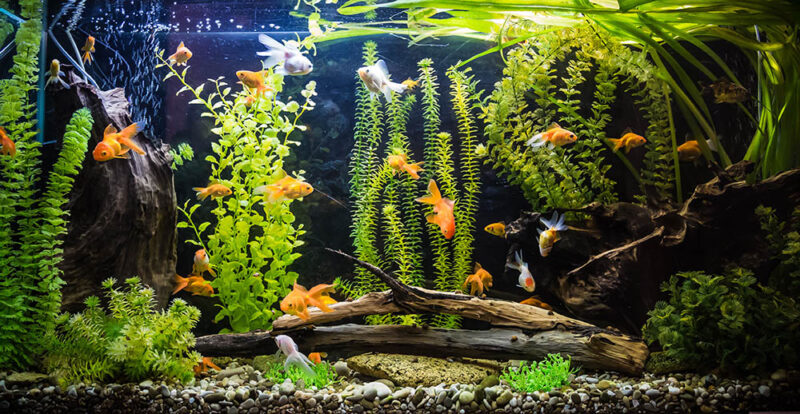
6. Choosing Healthy Goldfish
It is important to make sure that the goldfish you choose are healthy from the start. When goldfish are sick, it is a very time-sensitive matter. Goldfish will not typically show signs of illness until it is too late. When you are browsing for your goldfish, you want to make sure that you watch them swim around the tank for a few minutes before you decide to take them home. The goldfish should be active with fins that stand up comfortably around the fish. The other fish in the tank should be active and responsive.
If you move in front of the tank, the fish should respond to you and some may even attempt to follow you for food. A goldfish will associate a person coming close to the tank with feeding them; this will encourage them to swim up to you. The fish should have no white dots, growths, infections, or torn fins. The water should be clean, and the employees should practice good tank hygiene. It is important to notice if the fish has a bloated or sunken stomach. Both are undesirable in a healthy fish and could indicate an underlying illness.
Goldfish grow rapidly under the correct conditions and you may even have to upgrade them within the next few months. For that reason, we encourage you to get the largest tank possible for your goldfish before you purchase them.
7. Water Testing
Since we cannot see the levels of ammonia, nitrite, and nitrate in the water, we need to test the water regularly. This means that we must make use of a liquid testing kit. This will be able to give us a good indication of what the water parameters are within the water. This is an extremely important step that should be done at least once a week. Water testing when the tank is still new or cycling should be done every other day. In an established tank with fish, you should check the parameters at least twice a month, ideally once every week (with the weekly water changes).
The liquid testing kit should come with NH3, NO2, and NO3 test bottles. Liquid testing kits are recommended over testing strips as they are more accurate. It is important to follow the instructions on the pamphlet each time you test the water. Adding in the wrong bottle of drops will give you an inaccurate reading.
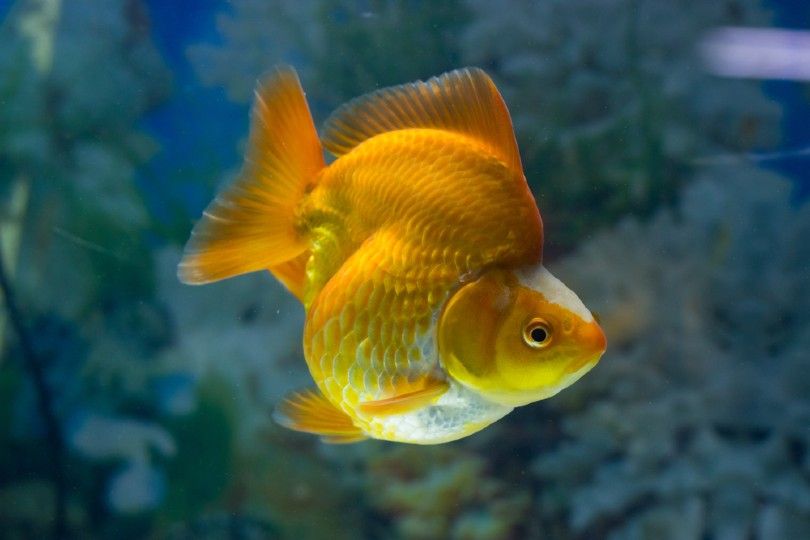
8. Feeding
Making sure that your goldfish receives a quality diet is important. A good goldfish food will be suited for omnivores and generally be labeled as ‘goldfish food’. Since other fish do not require the same diet as a goldfish, you should look for a species-appropriate food and not one that is tailored to the needs of other fish. For successful rearing of goldfish, goldfish require about 40% protein and 4.0 kcal /g energy.
You should also incorporate a variety of plant material into their diet as well as provide access to meat-based supplements. Daphnia, brine shrimp, tubifex worms, and bloodworms make great protein-rich foods to keep your goldfish healthy. These foods can be fed up to three times a week depending on the size of your goldfish and can be fed live, frozen, or freeze-dried.
Plant-based materials like algae wafers or sinking pellets, de-shelled peas, duckweed, cucumber, and lettuce can be fed to help with digestion and promote variety within the diet. The food should also sink so that your goldfish do not gulp air along with the food and cause issues with their swim bladder.
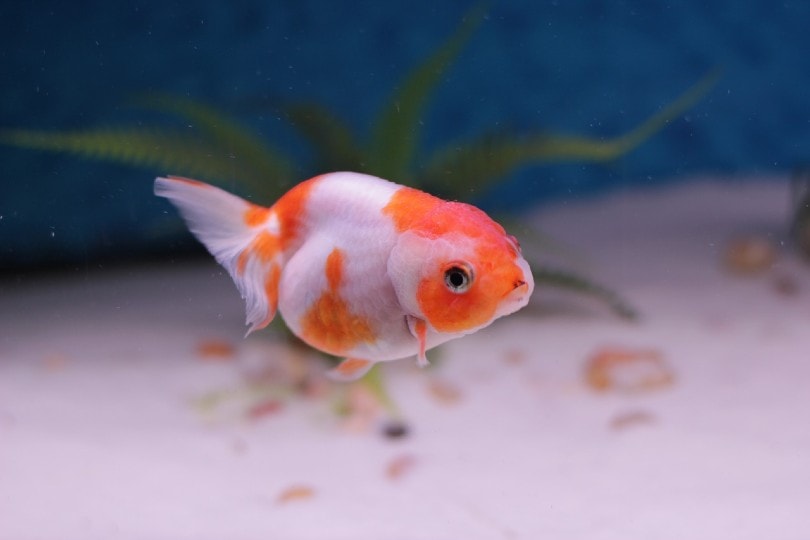
9. Accessories
Decorations help to provide shelter and safety within an aquarium. Goldfish are naturally prey animals that require plants, caves, rocks, and other sheltering aquarium decorations to feel safe. It is ideal to add in live plants that have thick leaves so your goldfish do not try to eat them. Anubias, hornwort, and Amazon swords are great plants for goldfish.
Other smooth-sided ornaments are also welcomed into a goldfish tank and can add color and enhance the view of the tank. Caves are also good for a goldfish to sleep inside; these decorations can be sold in the aquatic decoration section at your local fish store. They should have more than one large opening and not be able to fall on their side and block the exit. Goldfish do not need heavily decorated tanks, but they should not be sparse either.
10. The Nitrogen Cycle
Finally, the most important aspect of keeping any fish (not just goldfish) is ensuring that your aquarium is cycled before you add your fish inside. This process takes around 4 to 6 weeks on average. It is therefore imperative that you understand the concept of the nitrogen cycle before you purchase your fish. Failure to do so will likely lead to new tank syndrome.
Final Thoughts
Taking care of a goldfish is simple if you follow the essential care steps. Caring for your goldfish appropriately will allow you to have your goldfish remain healthy. This gives you plenty of time to spend bonding and enjoying the company of your playful fish friend. Once the basic requirements have been met, maintenance is simple enough that it will not take much time out of your day to care for them.
We hope this guide has helped inform you on some tips to care for your goldfish.
- You may also be interested in: Why is My Goldfish Turning Black? Here’s What to Do
Featured Image Credit: Skumer, Shutterstock







